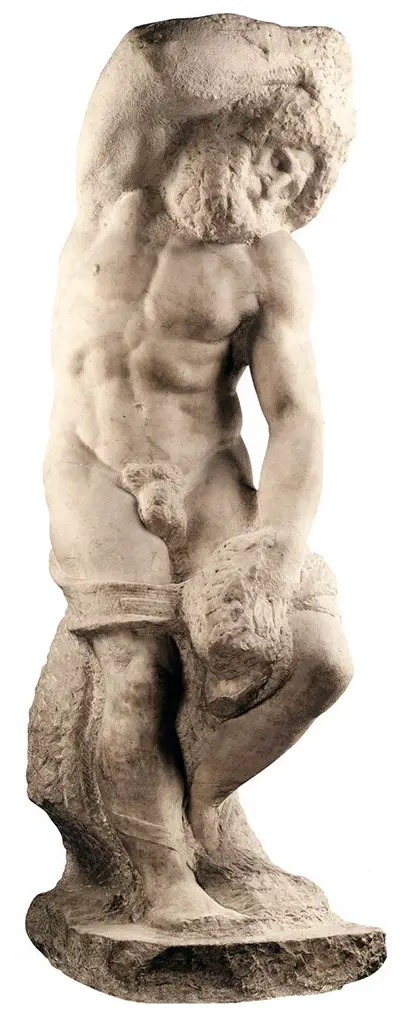This incredibly true-to-life statue is one of a set of four unfinished works named the Boboli slaves. Commissioned for the tomb of the Pope Julius II, the Bearded Slave is an anatomically well-developed, naked male with just a strip of fabric around his legs.
The pose presented is one of some physical torment. His weight is supported on the right leg, while the left foot is raised behind, with the left leg bent at the knee.
The slave’s shaggy head is half turned and tilted down onto his left shoulder. The right arm is raised and appears to be holding something above and behind his head.
This part of the carving is not complete, so it is not clear what the right hand is holding, but the lopsided posture gives the impression that he is carrying something heavy. The left hand, which has also not been completed, appears to be holding onto the strip of cloth around his legs just above the knees.
The sculpting of the legs is not as authentic as the rest of the figure, and may have been done much later, or even by someone else. This larger-than-life statue stands approximately 263-cm tall.
The Boboli Slaves
The four Boboli slaves, named after the Boboli Gardens in Florence, are a fine example of Michelangelo’s expertise as a stone sculptor, and also testimony to his thorough understanding of human anatomy. The fascinating appeal of these four sculptures is partly due to their “non-finito” (unfinished) state. The other three statues in this series are The Awakening Slave, The Young Slave, and The Atlas.h
These are the names given to them later by scholars; not by Michelangelo. These figures were commissioned in 1505 by Pope Julius II as part of the grand décor for his proposed tomb. The Pope then changed his mind and instructed Michelangelo to decorate the Sistine Chapel, the ceiling of which is his most famous work. After the Pope’s death, his nephews downgraded the tomb project to save money, and this is why so many of the artist’s sculptures are unfinished.
Michelangelo was to have produced thirty figures for Julius’s tomb, but with the downgrading, he only worked on six. Of the four Boboli Slaves, The Bearded Slave is the closest to completion, and they are all displayed at the Accademia Gallery, Florence.
Two other completed slave sculptures; The Rebellious Slave and The Dying Slave are at The Louvre, in Paris.
A lot of the intrigue with these unfinished sculptures is the representation; the slaves appear to be trapped by the material of their making and are struggling to free themselves. Whether that was Michelangelo’s intention is debatable.
It has even been claimed that he deliberately left the sculptures unfinished so as to represent the eternal human struggle to free oneself of material trappings. Whatever the intention, these works of art are not discredited for their unfinished state and have provided art scholars and enthusiasts alike with plenty of scope for artistic interpretation.
Sculpture Technique
Unlike other sculptors, who would prepare a plaster-cast then mark out the slab of marble in sections methodically; Michelangelo worked freehand to relieve each part of the figure to the finish from the rough block of marble. Not only must this have taken tremendous skill, but also gives the impression that the human figure is breaking free from the restraints of the solid marble. He was often so engrossed in his sculpting; he would work for days on end without a break or sleep.
Italian Renaissance
There is no doubt that Michelangelo was one of the greatest artists of The Renaissance period. The cultural changes sweeping the Western World during this period were the greatest influence since the fall of the Roman Empire. Dramatic reforms in religion, literature, philosophy, politics, and science were taking place, and Michelangelo was one of the frontrunners of the Italian Renaissance.
Early examples of his extraordinary talents are the Pieta, created for the Vatican, and the Statue of David for the city of Florence. A lot of Michelangelo’s work, including his paintings and frescos, were taken from mythological and classical sources. As well as being an incredibly talented artist and sculptor, Michelangelo was a highly accomplished architect. St. Peter’s Basilica is one of his best-known creations, an enormous ornate church built on the burial site of St. Peter, the first Pope.
The Artist
Born in 1475 in Tuscany, Michelangelo was the first artist to have his biography published during his lifetime. Giorgio Vasari described him as the greatest artist of the Renaissance in his writings. He is the most documented artist of the 16th-century. Along with Leonardo Da Vinci, although with totally differing attitudes to art, these two strong personalities influenced art development over several centuries. Michelangelo died in 1564 aged 88 years.


